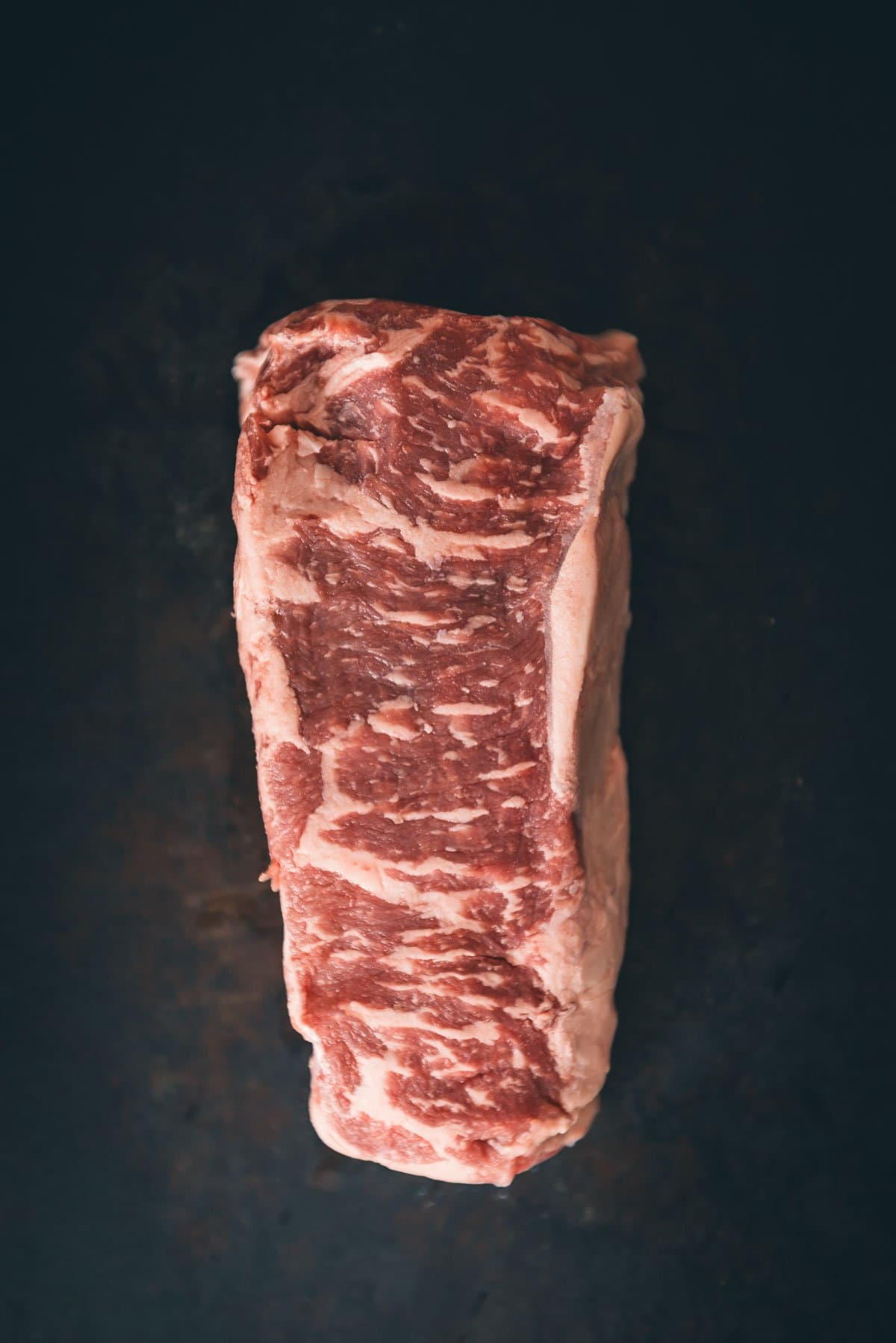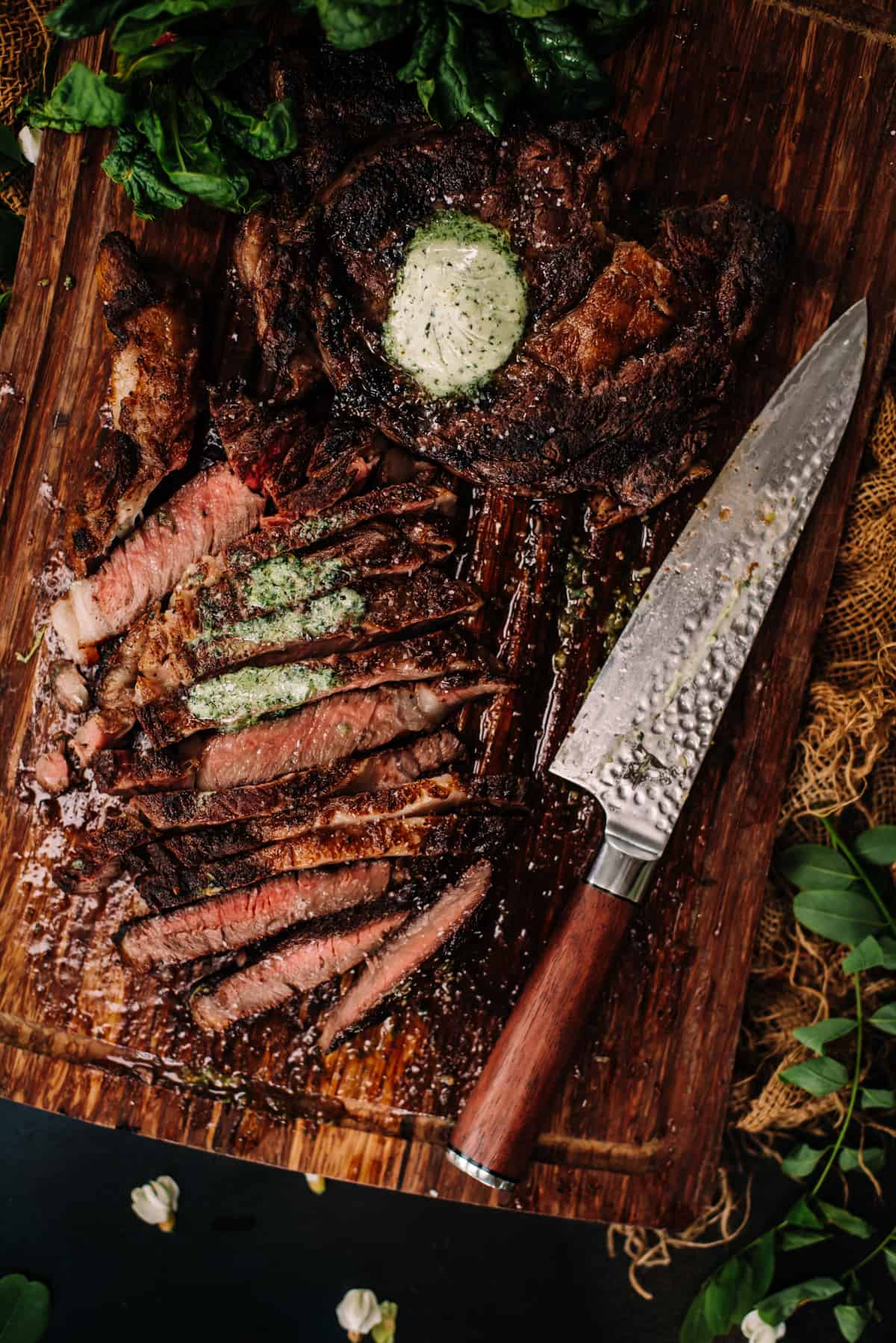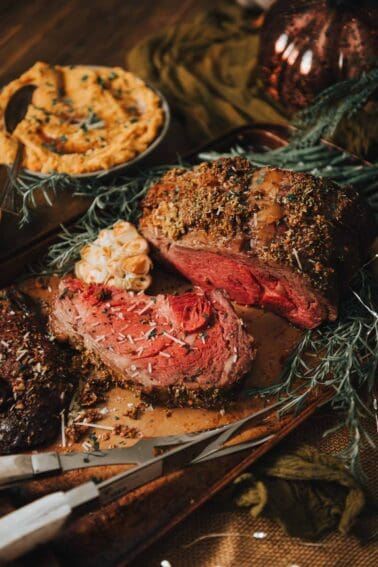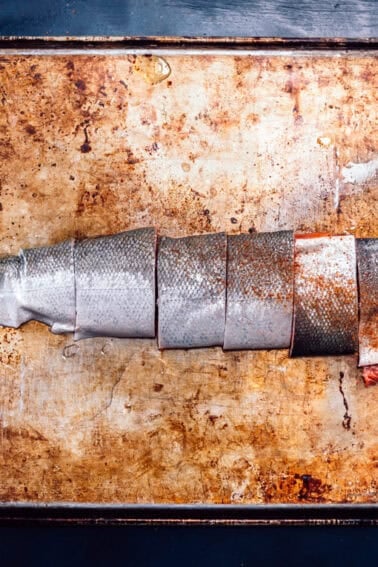Understanding the differences between the highest quality tiers of Prime vs Choice beef ensures you get the proper marbling, tenderness, and flavor to match your cooking method and budget. We explain what makes them unique in this beef grade comparison.

Table of Contents
- What Are USDA Beef Grades?
- Comparison to Prime Beef
- Prime Beef
- Prime Beef Cooking Tips
- Our favorite recipes for when we Splurge on Prime Beef
- Choice Beef
- Choice Beef Cooking Tips
- Our favorite recipes that can turn a Choice cut into a Masterpiece
- Maximizing Flavor and Tenderness
- Differences in Cooking Times and Techniques
- Personal Preferences and Budget
- More helpful How-to’s
Grades of beef are like scores that experts give to meat based on certain qualities. These meat grades help us understand how good the beef is in terms of things like tenderness, flavor, and overall quality. The most common beef label system is from the USDA (United States Department of Agriculture).
When we buy or cook beef, understanding these grades helps us choose the best meat for our preferences. The beef grading system takes into account factors like fat marbling (the little fat lines in the meat), color, and texture.
Higher grades, like Prime, have more marbling, making the meat tender and full of flavor. On the other hand, lower grades, like Choice, may not be as tender but can still be good for certain cooking methods.
Learn how to spot the differences between Prime Grade Beef and Choice Grade Beef so you can make the most informed decisions when making your beef recipes.

What Are USDA Beef Grades?
Beef grades are evaluations or scores given to beef based on specific characteristics that affect the quality of the meat by the United States Department of Agriculture (otherwise referred to as the USDA). The significance of these grades lies in helping consumers and professionals in the meat industry understand and choose beef that aligns with their preferences and intended cooking methods.
When experts grade beef, they consider various factors, and one of the key elements is marbling. Marbling refers to the thin streaks of intramuscular fat distributed throughout the muscle tissue. Abundant marbling usually results in juicier and more flavorful meat. Higher grades often have increased marbling, indicating superior quality. It’s why the ribeye is often a coveted cut, unlike the leanest cuts of beef.
The age of the cow is another factor influencing beef grades. Younger cattle typically produce more tender meat, contributing to a higher grade. The aging process, whether it’s dry or wet aging, can also impact tenderness and flavor.
Muscle development plays a role in determining beef grades as well. Well-exercised muscles in older animals may result in tougher meat compared to less-used muscles in younger ones. This is why cuts from less-worked muscles often receive higher grades for tenderness. For example, a filet mignon versus a beef shank.
Comparison to Prime Beef
| Prime Grade Beef | Choice Grade Beef |
|---|---|
| Higher grade. Abundance of marbling for exceptional tenderness and flavor. Typically found in high-end restaurants. Considered the top tier for premium dining experiences. | Slightly lower grade than Prime. Offers a good balance between quality and affordability. Has less marbling than Prime. Accessible option for those seeking quality without a premium price tag. |
Prime Beef
USDA Prime beef is the highest quality beef one can usually buy at your regular market. When you hear “Prime,” think top-tier steak cuts. It’s known for its exceptional tenderness, juiciness, and an incredible amount of marbling.
Marbling is those tiny white streaks of fat within the meat fibers, and in Prime beef, it’s abundant. This marbling gives the beef a luxurious texture and a rich, beefy flavor. Prime steaks are often the go-to choice for those special occasions or when you want an unforgettable dining experience.

Grading Prime Beef
The USDA Prime Label is the best of the best. The process involves evaluating the meat’s marbling, color, texture, and maturity. Marbling is the key player here – the more, the better. Expert graders from organizations like the USDA meticulously assess these factors.
When a cut of beef earns the Prime grade, it means it has the highest level of marbling, making it incredibly tender and bursting with flavor. It’s like the cream of the crop, the top-notch quality you can get.
Availability and Pricing of Prime Beef
Now, here’s the catch – Prime beef is top-notch, but it’s not always the easiest to find. You won’t see it piled up in every grocery store for every cut. It’s more commonly found in high-end butcher shops or specialty markets. Or for special cuts around the holiday season.
And, because Prime grade is considered the best of the best, it comes with a price tag to match. Prime beef is generally more expensive than lower-graded cuts due to its superior quality. The rarity and the meticulous care that goes into producing Prime beef contribute to its higher cost. So, if you’re splurging for a special occasion, Prime beef is the way to go, but be ready to pay a bit more for that top-tier dining experience.
Prime Beef Cooking Tips
- Grilling and Searing: Prime beef cuts are known for their marbling, making them some of the best steaks for grilling, like this reverse seared prime rib recipe and grilled bone-in ribeye steaks. Allow the meat to come to room temperature before cooking for more even results. Using a cast iron skillet is a great tool for cooking Prime beef. Just make sure to season your cast iron and clean your cast iron for the best results.
- Temperature Control: Use a meat thermometer to monitor the internal temperature. Prime beef is best enjoyed medium-rare to medium, ensuring that the marbling melts and enhances the flavor without overcooking.
- Resting Period: After cooking, let the Prime beef rest for a few minutes before cutting against the grain. This allows the juices to be redistributed, ensuring a juicy and flavorful result.
Our favorite recipes for when we Splurge on Prime Beef
Beef Recipes
Garlic Herb Prime Rib
Beef Recipes
Perfect Pan Seared Ribeye
Beef Recipes
Sous Vide Beef Tenderloin
Beef Recipes
Grilled Porterhouse Steak
Choice Beef
USDA Choice beef is a grade of meat that falls between Prime and Select in terms of quality. It’s known for having a good amount of marbling, which are those fine streaks of fat within the muscle fibers. This marbling contributes to the tenderness, juiciness, and overall flavor of the meat. Choice beef typically has a bright red color, indicating freshness and a decent texture, making it a popular choice for various cooking methods.

Availability and Pricing of Choice Beef
Choice meat is widely available in grocery stores and meat markets, making it a popular choice for everyday consumers. It strikes a balance between the premium quality of Prime and the more budget-friendly Select.
Due to its relatively higher quality, Choice beef is priced higher than Select but is still more affordable than Prime. It’s a great option for those looking for good quality, cheap cuts of meat. Availability may vary based on location and the specific preferences of local consumers and retailers.
PRO TIP: If you’re overwhelmed by the beef choices at your local grocery store, you can always buy meat online to save you time and energy.
Choice Beef Cooking Tips
- Marinating: While Choice beef has good marbling, marinating can enhance its tenderness and flavor. Use a flavorful marinade like our all-purpose steak marinade (or get even more zesty with our flank steak marinade), and allow the meat to soak for a few hours before cooking.
- Slow Cooking: Choice cuts can benefit from slow cooking methods, such as braising or stewing. This allows the meat to become tender and absorb the flavors of the cooking liquid, like in this oven-roasted eye of round recipe or slow cooker pot roast.
- Lower Temperature: When roasting Choice beef, consider a slightly lower cooking temperature compared to Prime cuts. This helps maintain tenderness without overcooking.
- Adding Fat: Adding compound butter on top of Choice beef at the end of the cooking process can help the meat absorb more fat, making it more tender and reminiscent of Prime beef.
- Pan-Searing: Pan-searing helps the meat retain its juices, leading to a more tender result. It’s the perfect cooking method for these pan-seared tri-tip steaks.
Our favorite recipes that can turn a Choice cut into a Masterpiece
Maximizing Flavor and Tenderness
- Seasoning: Both Prime and Choice beef respond well to simple seasoning with salt and pepper. Enhance the natural flavors without overpowering the meat. We love an overnight dry brine of salt on most cuts of beef. This helps us get amazing crusts on everything from a grilled steak to an inexpensive round roast.
- Resting Time: Let the cooked beef rest before slicing. This is crucial for both grades to ensure the juices are distributed evenly, preserving tenderness. Add a little more flavor by placing a knob of compound butter over your beef as it rests. It will melt and cost the meat in a layer of rich umami flavor.
- Quality Ingredients: Using quality ingredients, such as fresh herbs and aromatic spices, can elevate the overall flavor of the dish regardless of the beef grade. We splurge and buy high-quality infused olive oils to drizzle over food before serving. Rosemary and garlic are amazing over a good cut of beef, no matter what the grade is.
Differences in Cooking Times and Techniques
- Prime: Due to the higher marbling content, Prime beef may cook faster, depending on the cut and thickness, especially when grilling on a gas grill. Keep a close eye on the internal temperature and aim for a shorter cooking time to preserve the tenderness and flavor.
- Choice: Choice beef may require a bit longer cooking time, especially when using slow-cooking methods. The additional time allows the meat to become tender while absorbing the flavors of the cooking process.

Personal Preferences and Budget
When it comes to choosing between Prime and Choice beef, it’s important to think about your personal preferences. Consider what matters most to you in a steak or piece of meat. If you love a rich, melt-in-your-mouth experience with plenty of marbling, Prime might be the way to go.
On the other hand, if you’re content with good quality but don’t mind a bit less marbling, Choice could be your sweet spot. We have had plenty of ‘choice’ grade steaks that have tasted just as good as their more expensive options. Sometimes, it’s all in looking at the cut of beef to assess whether or not it’s going to be good.
Budget
Prime beef usually comes with a higher price tag compared to Choice. It’s like choosing between a luxury car and a reliable one – both get you where you want to go, but one might be a bit fancier. Understanding your budget is crucial. If you’re celebrating a special occasion or simply want the best, splurging on Prime could be justified. However, if you’re cooking for a regular weeknight dinner, Choice offers a fantastic balance between quality and cost.
Cooking Style
To make an informed choice, start by asking yourself a few questions. What’s your cooking style? If you’re grilling or searing, the extra marbling in Prime can make a significant difference. How often do you indulge in premium cuts? If it’s a rare treat, it might be worth it to go for Prime. On the other hand, if you’re a frequent beef enthusiast, finding that balance with Choice could be more budget-friendly without sacrificing much in taste.
Ultimately, the key is to understand your own preferences and needs. Don’t be swayed solely by the price tag – weigh it against what you truly enjoy in a good piece of beef. Whether it’s Prime or Choice, your satisfaction is what matters most.
More helpful How-to’s
High-quality beef doesn’t have to cost an arm and a leg. As long as you understand the different grades of beef, you can make an informed decision to best fit your preferences and lifestyle. We hope you’ll explore both Prime and Choice beef and play around with different cooking methods, seasonings, and steak cuts to find your perfect match.

























